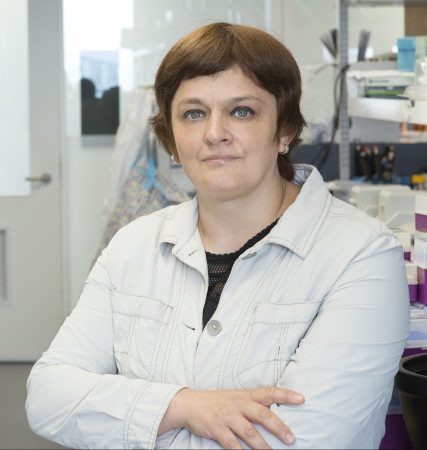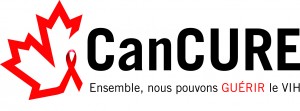
| Title: | Full time professor |
| Address: | Centre de Recherche du CHUM 900, rue Saint-Denis Tour Viger, R09.416 Montréal (Québec) H2X 0A9 |
| Phone: | 514-890-8000, ext. 35744 (office) 514 890-8000, ext. 31246 (labo) |
| Email: | petronela.ancuta@umontreal.ca |
Biography
To come up
Team
- Delphine Planas, Ph.D. Student
- Amélie Cattin, Ph.D. Student
- Tomas Raul Wiche Salinas, Ph.D. Student
- Natalia Fonseca Do Rosario, visiting Ph.D. Student
- Etiene Gabriel Moreira, Ph.D. Student
- Debashree Chattarjee Adhikari, Ph.D., postdoctoral fellow
- Younes Chouikh, Ph.D., Research Assistant
- Laurence Raymond Marchand, M.Sc., Research Assistant
Themes
- Immunology
- Virology
Research topics
HIV is unique in its ability to target key cells in the immune system and to escape cellular and molecular antiviral responses. Current antiretroviral therapy (ART) is a major asset of modern medicine that has turned HIV / AIDS into a manageable chronic disease in countries where access to treatment is possible. However, HIV eradication is not achieved with ART. The persistence of HIV reservoirs in small fractions of CD4 + T cells is very well documented. In contrast, the contribution of other types of immune cells such as myeloid cells to the persistence of HIV during ART remains to be established. Thus, in recent years, research in my laboratory has focused on the identification and molecular characterization of discrete subpopulations of CD4 + T lymphocytes and permissive myeloid cells versus those resistant to HIV infection. Our goal is to generate new scientific knowledge to support the implementation of new healing / remission strategies in people with HIV infection.
The research program of my laboratory is described below:
Th17 and HIV Cells: Our findings placed Th17 cells (a subset of CD4 + T cells that fight mucosal pathogens) at the very heart of HIV persistence in infected subjects receiving ART. Our current efforts are aimed at identifying transcriptional regulators specific for Th17 cells that could be used as antiviral targets to limit HIV transcription in new “block and lock” strategies.
Myeloid cells and HIV: We have identified CD16 + monocyte-derived dendritic cells as major contributors to HIV pathogenesis and reservoir persistence through the production of soluble pro-inflammatory and immune regulatory molecules. Current research in the laboratory is aimed at studying myeloid cells derived from embryonic / fetal precursors (capacity for self-renewal and long-term survival) versus monocytes (short survival), in terms of inflammatory potential and contribution to the persistence of HIV in infected people receiving ART.
Circadian rhythm and HIV: More recently, my laboratory is investigating the importance of circadian rhythm and circadian clock machinery in regulating immunologic functions and the multiplication of HIV. It is increasingly understood that deregulation of this clock has harmful immune implications especially in HIV-infected individuals. These studies have a strong clinical relevance to guide HIV eradication strategies.
These studies are partly done in the context of the Canadian HIV Healing Research Consortium (https://www.cancurehiv.org/people; PI: Dr. Eric Cohen, Ph.D.), funded by the Canadian Institutes of Health Research. Health Canada (CIHR), in partnership with the International AIDS Society (IAS) and the Canadian Foundation for AIDS Research (CANFAR). Access to well-defined longitudinal cohorts of HIV-infected people (PI: Dr. Jean-Pierre Routy, M.D.) is facilitated by financial support from the FRQ-S HIV / AIDS Network.
Cardiovascular Disease and HIV: In parallel, my lab is participating in pan-Canadian collaborative efforts to identify the cellular and molecular mechanisms of premature aging and cardiovascular disease in the HIV-infected population, including the role of a novel cytokine IL-1. 32. In these studies, we have access to the Canadian cohort on aging and cardiovascular disease in HIV-infected people (PI: Cécile Tremblay, M.D. and Madeleine Durand, M.D.). These studies are funded by CIHR and the National Institutes of Health (NIH).
Publications
- Wacleche VS, Goulet JP, Gosselin A, Monteiro P, Soudeyns H, Fromentin R, Jenabian MA, Vartanian S, Deeks SG, Chomont N, Routy JP, Ancuta P*. New insights into the heterogeneity of Th17 subsets contributing to HIV-1 persistence during antiretroviral therapy. Retrovirology. 2016 Aug 24;13(1):59. doi: 10.1186/s12977-016-0293-6.
- Gosselin A, Salinas TR, Planas D, Wacleche VS, Zhang Y, Fromentin R, Chomont N, Cohen ÉA, Shacklett B, Mehraj V, Ghali MP, Routy JP, Ancuta P*. HIV persists in CCR6+CD4+ T-cells from colon and blood during antiretroviral therapy. AIDS. 2017 Jan 2;31(1):35-48.
- Delphine Planas, Yuwei Zhang, Patricia Monteiro, Jean-Philippe Goulet, Annie Gosselin, Nathalie Grandvaux, Thomas J. Hope, Ariberto Fassati, Jean-Pierre Routy, and Petronela Ancuta*. HIV-1 selectively targets gut-homing CCR6+CD4+ T-cells via mTOR-dependent mechanisms. JCI Insight. August 2017.

